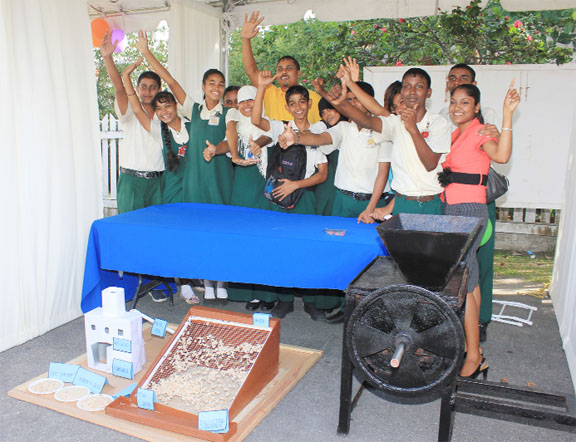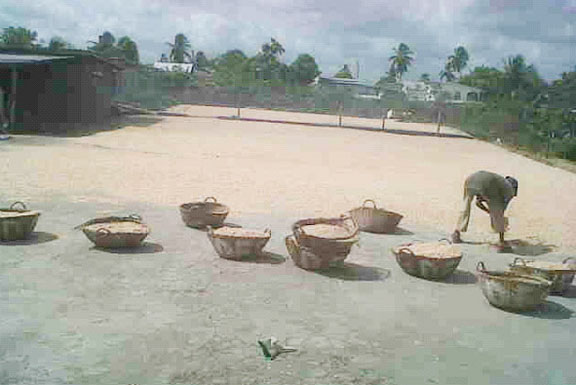The winning entry in a national schools science and technology competition submitted by Zeeburg Secondary School seems set to solve an age-old problem plaguing much of the small West Coast Demerara community.
At the same time, the invention, fashioned by a group of fourth formers with the support of their Agriculture Science teacher, could provide an opportunity to improve the manufacturing process in an industry that is important to the economic well-being of the community.

Many of the residents of Zeeburg and neighbouring communities make a living from catching, boiling, salting and drying shrimp for both the local and export market. The shrimp is processed on the seawall close to the Zeeburg Secondary School. The stench is often unbearable, and for years the school population simply had to grin and bear it.
The Zeeburg fourth formers chose the opportunity presented by the competition sponsored by the Trinidad and Tobago-based financial company Sagicor to apply Science, Technology, Engineering and Mathematics (STEM) to produce a device that would solve an environmental problem in the community.
The issue of the stench of boiled shrimp being put out to dry close to the school has long been the reason behind a standoff between the school community and the fishermen and has even reached the level of the regional administration. Challenged to produce a credible entry for the Sagicor Visionaries Challenge Competition it occurred to the students that they might kill two birds with one stone.
The idea is simplicity itself. It offers a way of drying the shrimp in an enclosure that locks the scent away, and which, moreover, completes the drying process much quicker.
The conventional method of processing or drying shrimp involves six steps. The catch is first cleaned then sorted by hand to separate fish from shrimp. Next, the shrimp is salted and boiled for about 20 minutes. Afterwards, it is placed in baskets and taken to the drying board, a stretch of seawall, where it is left to dry for a period of about three days. It is during the drying process that the controversy ensues.

At the end of the drying period the shrimp is placed in rice or salt bags and beaten against the sea wall several times then passed through a sieve to remove dust and other unwanted material. After that, the preserved shrimp is further cleaned by hand. A few enterprising shrimp processors have acquired a mill, which through a process known as agitation, separates the processed shrimp from the husk.
Over the past few weeks the Zeeburg secondary students have developed a model of what is perhaps best described as an oven that seeks to replace the open air drying on the seawall with a process of baking. They recommend that the oven which can be manufactured at a cost of around $5 million be housed in a building. They point out that apart from bringing a significant measure of relief to the school population and other residents of the community, the new method is more efficient, technologically advanced and quicker.
While some amount of discussion has already ensued among the inventors, the fishermen and a few businessmen whom, we are told, may be interested in investing in the technology, no deal has been struck as yet. The fishermen, while seemingly not averse to embracing the new technology still appear mindful of the old grudge arising out of what they felt might have been an attempt by the school community to relieve them of their livelihood.
Businessmen that they are, however, they are not indifferent to the prospects which the new invention might hold. Some of them are wondering whether either the Ministry of Agriculture or the local business community, or both may consider investing in the piece of equipment that could see the young scientists from Zeeburg make a name for themselves.
There is another reason why the emergence of a drying factory excites them. Currently, the drying process is conditioned by the weather. An all weather factory will help them overcome their weather woes.
The oven itself will be made of concrete and lined with mesh. The shrimp will be placed on the mesh to bake. The heat will be generated through a wooden furnace and conducted into the oven via a metal pipe. Afterwards, the shrimp will be manually swept into containers.
After it was announced last week that the Zeeburg entry had won the competition, the oven attracted even more attention. Students and teachers spoke about how much it would mean to bring an end to the vomiting and headaches that sometimes afflict sections of the school population on account of the nausea resulting from the stench. While that may not yet be behind them, the school population, the processors and the community as a whole are enthused by the breakthrough and hopeful that their invention will, among other things, realise an economic breakthrough for the local shrimp processing industry.
Clearly enthused by the prospects, the dried shrimp producers talk glibly about the possibility of exporting to Barbados. Much of what they produce is currently sold to a buyer in Berbice. They are keen to do “bigger business”.
Perhaps surprisingly, information on export procedures does not appear to be at the disposal of the dried shrimp manufacturers.





